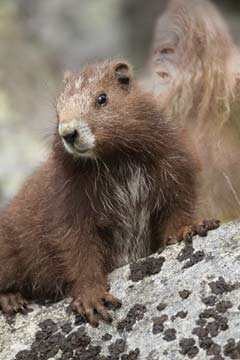Pixy was born at the Toronto Zoo, as part of a captive breeding program aimed at recovering this uniquely Canadian species. This summer, Pixy was released to the wild, but only after a year of ‘school.’ It’s a strategy conservationists working to protect the marmots believe is helping the species make a comeback in some of the Island’s harshest environments, like the sub-alpine of Strathcona Provincial Park.
Strathcona Park is the largest protected area on Vancouver Island. Two and half thousand square kilometers of lakes, mountain peaks, glaciers, and forest, it is home to some of the most incredible scenery and wildlife in the world; including about fifty of the rare Vancouver Island marmot. But that wasn’t the case just a few year ago. The marmot had been completely lost in the Park, part of a decline of the entire species that left fewer than 30 in the wild in 2003. As recovery efforts ramped up, the first priority was marmot habitat further south, but Strathcona was always part of the plan.
“We wanted to start where the last remaining marmots had survived, on Mount Washington and handful of mountains further south, but we knew we’d be bringing marmots back to Strathcona at some point,” recalls Cheyney Jackson, the Marmot Recovery Foundation’s Field Coordinator. “I remember when the first releases to Strathcona happened in 2007, I was pretty excited to see marmots go back into the Park.”
Unfortunately, those first released marmots struggled to survive. “The Park seems like a perfect habitat, but in hindsight, it’s clear there were going to be challenges here that we hadn’t faced before.” The winters in Strathcona come earlier and end later, leaving the marmots with less time to prepare for a long hibernation. Plus there was no marmot “infrastructure” left. “Marmots use the same burrows and hibernacula for many, many years,” Cheyney explains, “but all those homes and hideouts disappeared with the marmots.”
Perhaps most importantly, there weren’t any resident marmots to show these newcomers the ropes. Marmots are social animals, and their colony structure helps new marmots learn how to avoid predators, and teaches them the best places to sleep and when to start and end hibernation. With that realization, a plan was hatched.

What if marmots could be taught how to survive before they went into Park?
That’s why Pixy is being released for the second time. Last year, when she was released for the first time, she was let go at Mount Washington. “Mount Washington is a gentle colony for the marmots. The people keep away most of the predators, and the hills are lush with vegetation,” Cheyney says. It’s like marmot grade school – they get to learn about life in the wild, but some of the hard edges are removed. Then, earlier this year, Pixy was caught again, and transported to Castlecrag. Her year at Mount Washington greatly improves her chances of surviving in this more remote and rugged mountain.
“The research suggests she’s about 5 times more likely to survive and produce pups of her own with this year of learning under her belt,” says Cheyney. It’s a big difference, and it has allowed marmots to begin the process of recolonizing their old meadows in the Park. “We’re seeing second and third generation marmots now, it’s thrilling.” These survivors are busy revitalizing the burrows, hibernacula, and meadows used by their great-great-grandparents, and will be ready to welcome new friends that arrive in the future. It’s amazing what a bit of education can do.
The Marmot Recovery Foundation is always interested in hearing reports of marmots, and pictures are encouraged.
Send your sightings to info@marmots.org or call 250 390-0006. to learn more go to http://marmots.org
